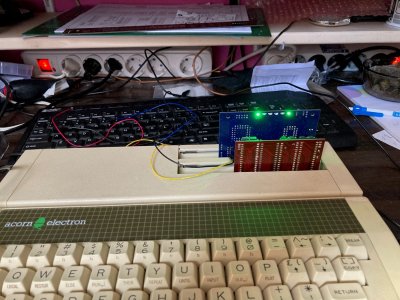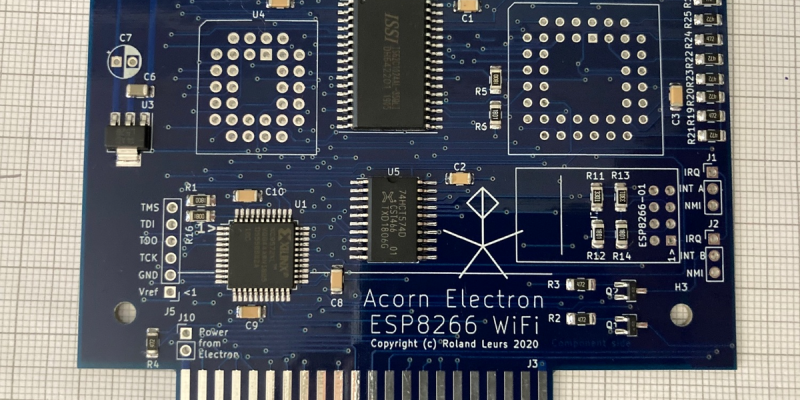In the continuing quest by countless hobbyists to allow every 1980s 8-bit home computer to experience the joys of an online experience that doesn’t involve a 9600 baud modem, [Roland Leurs] has created a cartridge-based module for the Acorn Electron that adds WiFi, which he showed off at the virtual ABug conference in September 2020.
The Acorn Electron is a Synertek 6502-based computer that was released in the UK in August of 1983. It’s a budget version of the well-known BBC Micro educational/home computer, with 32 kB of RAM and featuring BBC BASIC v2 in its ROM. [Roland]’s ElkWiFi card slots into an available cartridge slot, after which the onboard ESP8266 (ESP-1 module) can be enabled and used as a WiFi modem.

The board features the Exar ST16C2552CJ dual UART chip, one channel of which connects to the ESP-1 module, with the other channel used as an uncommitted UART header. The control logic is implemented in VHDL and flashed to the onboard Xilinx CPLD, and a 128 kB RAM module is used as WiFi data buffer.
Although a definite niche product, reading through the forum thread makes one really appreciate the technical complexity and joy once things are beginning to work reliably. It also shows one of the few cases where an ESP-1 module is used for its original purpose: as an easy way to add WiFi functionality with full WiFi and TCP stack, without burdening the main CPU.
(Thanks, BaldPower)
















Nice board! Glad to see new stuff being built for CLASSIC computers (because OLD – as the people from Retrocomputaria use to say – is your PC)
Thank you for your kind review.
“The Acorn Electron is a Synertek 6502-based”
Actually, the Acorn Electron is a Rockwell 6502-based computer. ;)
The Electron used the Synertek variant of the 6502 processor as that allowed the clock to be stopped for the entire 40 microseconds the ULA required exclusive DRAM access per raster line in high-bandwidth screen modes (source: Wikipedia).
The Acorn Electron was an affordable, educational machine. The BASIC interpreter had a built in assembler (like the BBC micro) so was my first introduction to “machine code” at the tender age of about 12. Unfortunately, mine met it’s end due to being stored for far too long in the attic, but this WiFi board would have been a great addition.
You could buy the electron, the plus 1 (cartridge interface) and plus 3 (3.5″ floppy disk drive and interface) for £69.99 making it one of the cheapest but also most well designed options. It didn’t have the “teletext” mode of the BBC micro but the architecture featured a proper BIOS with documented system calls. Great piece of kit. From memory, the cartridge slots mapped over a paged ROM address space so you could switch memory banks in and out under software control.
The other really historically important thing is that this was one of (I think) 2 designs that led to Acorn RISC Machines (the BBC and the Electron), The next design was (from memory) the RM Nimbus notable for the first incarnation of “Fleet Street Editor” which preceded software like MS Publisher (My school maths teacher was one of the developers for FSE back in the late 80’s and one of the reasons I ended up writing software for a living). I think the RM was short for RISC Machines, hence Acorn RISC Machines which eventually became Advanced RISC Machines or ARM – now the dominant microprocessor provider for smartphones, tablets, internet routers and well all sorts as you all know.
So maybe just a humble 6502 8bit machine, but the one of the parents of modern mobile technology.
plus 3 was £229 on release, so your combo £69.99 price must be 1995 clearance sale.
Historical note: RM was Research Machines (Wikipedia) who were big in the UK education market. They were based at the ‘other university’ town (Oxford as opposed to Acorn who were attached to Cambridge). RM used Z80 processors (from memory).
ASIDE: Sintel was an earlier version of RM. They sold an early digital alarm clock kit that I still use daily.
Hi Ian
I’d very much like to include a modern photo of the Sintel alarm clock on the RM Nimbus Museum website if you fancy providing some photos? I’ve only so far seen grainy magazine snippets from the 70s!
http://www.thenimbus.co.uk – contact details on there, be great to hear from you.
Cheers
Darren
Electron, known for two things. Being 4-bit (bus), and bankrupting Acorn.